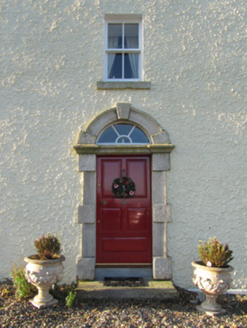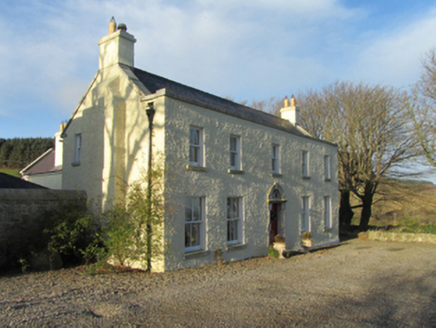Survey Data
Reg No
60260039
Rating
Regional
Categories of Special Interest
Architectural, Artistic, Historical, Social
Original Use
Farm house
In Use As
Farm house
Date
1700 - 1837
Coordinates
320053, 221018
Date Recorded
21/03/2013
Date Updated
--/--/--
Description
Detached five-bay two-storey farmhouse, extant 1837, on an L-shaped plan with single-bay (single-bay deep) single-storey double-pile return with half-dormer attic (west). Occupied, 1911. Sold, 2000. Restored, 2002-3. Pitched slate roof on an L-shaped plan behind parapet with pitched double-pile (M-profile) slate roof (west), clay ridge tiles, cut-granite coping to gables with rendered chimney stacks to apexes having stepped capping supporting terracotta tapered pots, and concealed rainwater goods retaining cast-iron ogee hoppers and downpipes. Roughcast walls on rendered chamfered plinth with cut-granite coping to parapet. Segmental-headed central door opening with cut-granite step threshold, and cut-granite block-and-start surround centred on keystone framing timber panelled door having fanlight. Square-headed window openings with cut-granite sills, and concealed dressings framing replacement two-over-two timber sash windows without horns. Interior including (ground floor): central hall retaining carved timber surrounds to door openings framing timber panelled doors; and carved timber surrounds to door openings to remainder framing timber panelled doors with timber panelled shutters to window openings. Set in landscaped grounds with roughcast piers to perimeter having shallow pyramidal capping supporting wrought iron double gates.
Appraisal
A farmhouse representing an important component of the domestic built heritage of south County Dublin with the architectural value of the composition suggested by such attributes as the deliberate alignment maximising on scenic vistas overlooking rolling grounds; the compact plan form centred on a Classically-detailed doorcase not only demonstrating good quality workmanship in a silver-grey granite, but also showing a simple radial fanlight; the diminishing in scale of the openings on each floor producing a graduated tiered visual effect; and the parapeted high pitched roofline. Having been well maintained, the elementary form and massing survive intact together with quantities of the original or replicated fabric, both to the exterior and to the interior, thus upholding the character or integrity of the composition. Furthermore, adjacent outbuildings (extant 1837) continue to contribute positively to the group and setting values of a neat self-contained ensemble having historic connections with the Roe family including Hugh Roe (----), 'Farmer [and] Stonecutter' (NA 1911); and Thomas Roe (----) 'of Ballybetagh House' (Proceedings of the Royal Irish Academy 1938, 206).









